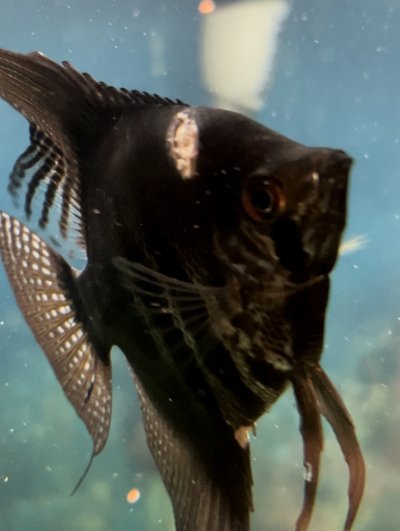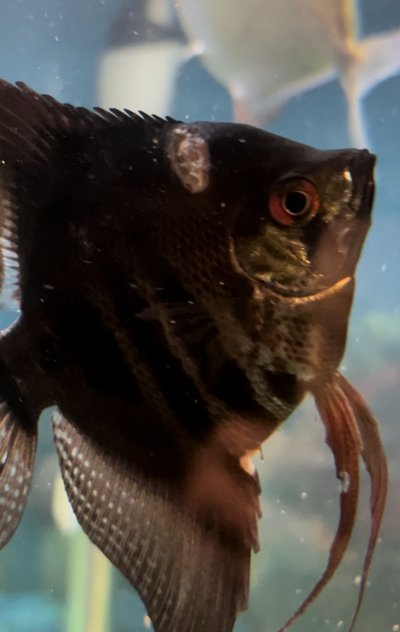Hi and welcome to the forum

It's not velvet. Velvet looks like the fish have a gold/ yellow sheen over part of their body. You can see velvet if you shine a torch (flashlight) on the fish after dark. Or if you take a photo of the fish with the camera flash on. It causes the yellow/ gold sheen to show up quite well.
The angelfish looks like it has a hole/ physical wound on the body. This could be caused by swimming into something or being attacked by something. The most common culprit is algae eating catfish (Chinese algae eaters, bristlenose catfish, plecos, sharks). You should monitor the fish and if you see any latching onto the angelfish, they are probably the guilty party.
It could also be an ulcer caused by bacteria. Ulcers usually occur over a period of a week or more and start out as a small red or white dot that gradually spreads, producing a large open wound. Ulcers need to be treated with a broad spectrum fish medication that treats bacteria and fungus. (Do not use antibiotics unless it is a known bacterial infection that has not responded to normal treatments). You can also try salt (1-2 heaped tablespoons of salt per 20 litres of water). Keep salt in the water for 1 week after the wound has healed.
------------------
To help the wound with healing, do the following.
Test the water for ammonia, nitrite, nitrate and pH.
Wipe the inside of the glass down with a clean fish sponge. This removes the biofilm on the glass and the biofilm will contain lots of harmful bacteria, fungus, protozoans and various other microscopic life forms.
Do a 75% water change and gravel clean the substrate every day for a week. The water changes and gravel cleaning will reduce the number of disease organisms in the water and provide a cleaner environment for the fish to recover in. It also removes a lot of the gunk and this means any medication can work on treating the fish instead of being wasted killing the pathogens in the gunk.
Make sure any new water is free of chlorine/ chloramine before it is added to the tank.
Clean the filter if it hasn't been done in the last 2 weeks. However, if the filter is less than 6 weeks old, do not clean it. Wash the filter materials/ media in a bucket of tank water and re-use the media. Tip the bucket of dirty water on the garden/ lawn. Cleaning the filter means less gunk and cleaner water with fewer pathogens so any medication (if needed) will work more effectively on the fish.
Increase surface turbulence/ aeration to maximise the dissolved oxygen in the water.
If there's no improvement after a few days of water changes and gravel cleans, add some salt.
------------------
SALT
You can add rock salt (often sold as aquarium salt), swimming pool salt, or any non iodised salt (sodium chloride) to the aquarium at the dose rate of 1 heaped tablespoon per 20 litres of water. If there is no improvement after 48 hours you can double that dose rate so there is 2 heaped tablespoons of salt per 20 litres.
Keep the salt level like this for at least 2 weeks but no longer than 4 weeks otherwise kidney damage can occur. Kidney damage is more likely to occur in fish from soft water (tetras, Corydoras, angelfish, Bettas & gouramis, loaches) that are exposed to high levels of salt for an extended period of time, and is not an issue with livebearers, rainbowfish or other salt tolerant species.
The salt will not affect the beneficial filter bacteria, fish, plants, shrimp or snails.
After you use salt and the fish have recovered, you do a 10% water change each day for a week using only fresh water that has been dechlorinated. Then do a 20% water change each day for a week. Then you can do bigger water changes after that. This dilutes the salt out of the tank slowly so it doesn't harm the fish.
If you do water changes while using salt, you need to treat the new water with salt before adding it to the tank. This will keep the salt level stable in the tank and minimise stress on the fish.
When you first add salt, add the salt to a small bucket of tank water and dissolve the salt. Then slowly pour the salt water into the tank near the filter outlet. Add the salt over a couple of minutes.
If there's no improvement after a week with salt, post more pictures and start looking for a broad spectrum medication.


